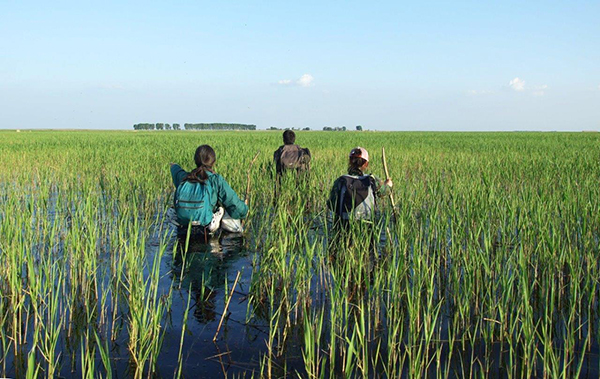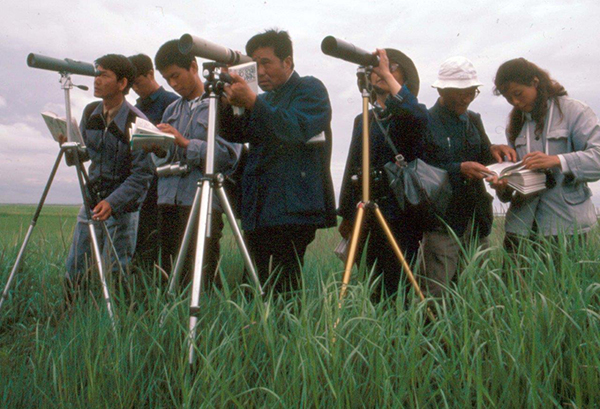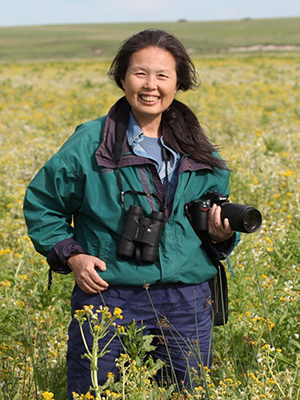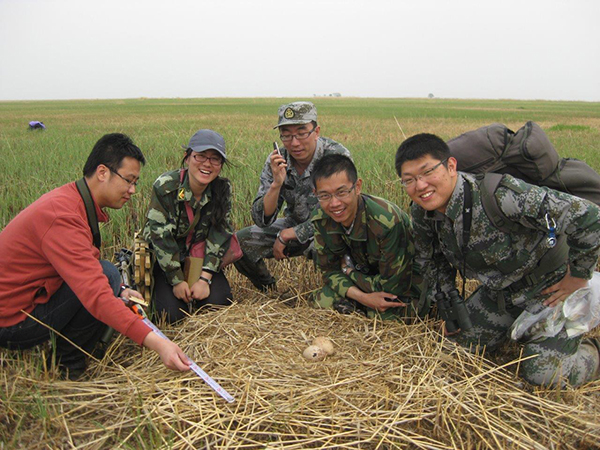
Zhalong is one of the great crane marshes of China, with the highest breeding numbers of endangered Red-crowned Cranes in the world. Zhalong was the first wild place where the International Crane Foundation worked in China. In 1983-84 Co-Founders George Archibald and Ron Sauey organized expeditions of American volunteers to count cranes and waterbirds. Fresh out of college, Su Liying was a witty junior biologist at Zhalong, and so excited to learn about field research. She helped guide George and Ron.

Eighteen years later, the 520,000-acre wetland was drying out. After 2000, fires burned through the marsh every year, eating deep into its peat soils. For Liying, now a Research Associate with the International Crane Foundation, the problem was more serious than drought. A network of canals and dikes, gradually constructed piece by piece, now blocked almost all water inflows. Evaporation in this arid region is intense. The once watery landscapes thirsted for water. Liying and others from the International Crane Foundation worked with Chinese counterparts to document the problem and develop potential solutions. Fortunately, the canal system already had gates that could release water into the upper parts of the marsh, restoring habitat for Red-crowned Cranes and other waterbirds. In 2008, the Provincial Government set up a special fund to pay for water releases.

Liying knew that successful wetland restoration depended on monitoring the results, then evaluating and adjusting the water flows. Liying devised a plan to record birds, plants and water at set locations year after year. During her years working for the nature reserve, Liying had walked far and wide. Although people said the vast Zhalong Marsh could never be crossed on foot, she devised a route for hiking entirely across the widest and most crane-rich portion. Liying had no difficulty recruiting students – and others – to join her annual treks. From the early years, she had friends who lived on islands in Zhalong. The team would stay with a family on one island the first night, and on another island the second night, walking out of the marsh late the third day. She led the first walk in May 2007, encountering a treacherous channel where her small group had to navigate over dangerous floating sedge mat. Liying was 51 when she began. She could outwalk many of the students. Yet they encouraged each other as they walked, knowing that teamwork is what conservation needs to succeed. Trudging for hours through monotonous reeds, the trek became their commitment to conservation – and for some, a commitment that would last a very long time.
Once they came upon a broad nest platform, a crane nest. The group could hear the chick peeping inside. One man was so excited he had to call his mother. Liying loved the excitement on their faces. Ten years of memories. Once when they reached the island house, an exhausted woman sank gratefully down on the edge of a heated kang (traditional stove-warmed bed). When she grabbed a thick, folded blanket on the kang, two dozen wild duck eggs fell out on the floor. The son of the family was trying to hatch eggs he’d taken from the marsh.

Each year Zhalong was different. Their lunch spot one year would be under water the next. For a few years, no one could sit anywhere during the entire three days because it was so wet, except on the islands where they slept. Wading through the vast marsh was physically demanding. And when reed stems from the previous year remained uncut – dense and far taller than Liying or her companions – they had to push ahead without landmarks to guide them through the endless stems. As the years passed, Liying let the young ones carry more of the gear and food. The ninth year brought tall reeds and deep, cold water – she was 60. It left her tired. But the tenth year was easier. When her group came to the first night’s island, she learned that her hosts would soon be leaving. The government was removing houses and people from three islands in the marsh to reduce disturbance. She took a side trip to abandoned home sites already demolished, remembering friends over the last 25 years as she witnessed the passing of an era.
There will be no walk this year. The trek would be too difficult without the island houses. Instead, Liying and two of her students will be analyzing ten years of data, to prepare recommendations on marsh restoration. Already it’s clear that vegetation has responded well and promptly to better water conditions. But the birds have lagged behind, far fewer than in the 1980s as witnessed by George and Ron. While Liying hopes conditions will improve within the marsh, much of the problem lies along the perilous flyways north and south. “I’ve been lucky these thirty-five years,” recalls Liying “time makes for strong connections, I hope Zhalong always has deep friendships. I look to these young people for the future.”
ConocoPhillips and the Fifth Age of Man Foundation have supported the Zhalong treks. We are also very grateful to Zhalong National Nature Reserve for assistance.
 Story submitted by Jim Harris, International Crane Foundation Senior Vice President. Click here to learn more about our East Asia Programs.
Story submitted by Jim Harris, International Crane Foundation Senior Vice President. Click here to learn more about our East Asia Programs.
